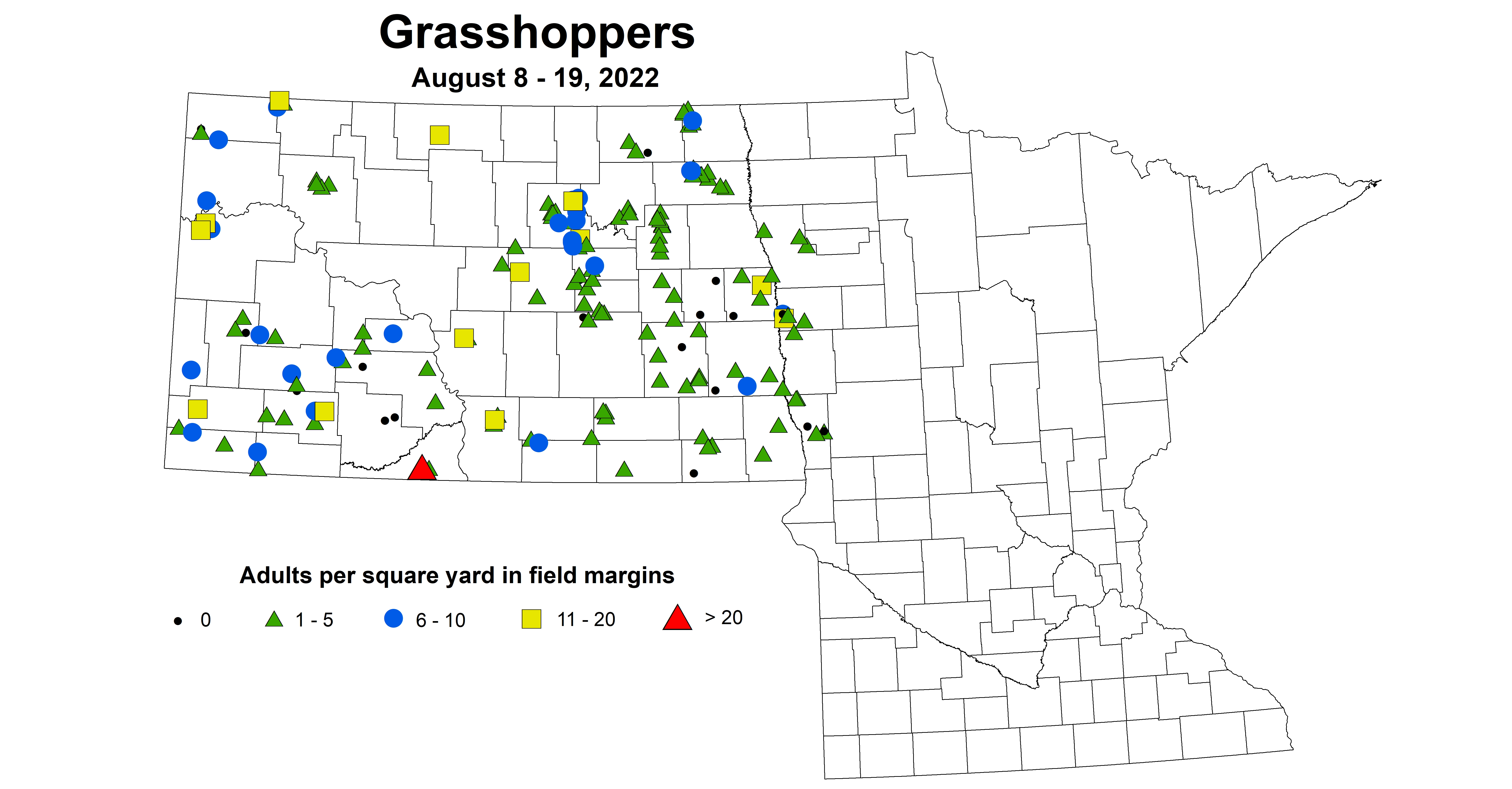Scout for Grasshoppers in Maturing Crops
This page was adapted from the article, "Scout for Grasshoppers in Maturing Crops," which appeared in Crop & Pest Report on August 25, 2022.
Continue to scout for grasshoppers in maturing field crops, especially after the small grain harvest since adult grasshoppers will move off of harvested fields in search of ‘greener’ field crops. Adult grasshoppers also can clip heads off when foliage is dying or has been heavily defoliated. It is not uncommon to see a mixture of adult and nymph grasshoppers this year due to the cool spring, which delayed egg hatching, nymphal growth and development, and emergence of winged adults. The five most common field crop grasshoppers in North Dakota are the clearwinged grasshopper (Camnula pellucida), two striped grasshopper (Melanoplus bivittatus), migratory grasshopper (Melanoplus sanguinipes), differential grasshopper (Melanoplus differentialis) and red legged grasshopper (Melanoplus femurrubrum).
Cropland grasshopper species emerge at different seasonal times. Early hatching grasshoppers in mid-spring are clearwinged grasshopper, two striped grasshopper and migratory grasshopper. The two striped grasshopper is usually the first to appear in the spring. Late spring hatching grasshoppers are the differential grasshopper and red legged grasshopper. The red legged grasshopper also is known for prolonged hatch due to the female placing eggs in various crops like soybean fields. Egg hatching is first observed along south facing slopes in field and range sites where there is little vegetative cover and soils are sandy. After rain and warm temperatures, flushes of egg hatching often occur.
IPM Crop Scouts observed grasshoppers in 82% of the fields scouted August 8 - 19, 2022 . The average number of adult grasshoppers per square yard ranged from 1 to 12. Economic populations of adult grasshopper are when more than 8 adult grasshoppers per square yard are present in field and when more than 21 adult grasshoppers per square yard are present in margins of fields.

If it is necessary to treat with an insecticide, check PHI (Preharvest Interval) of your insecticide label. “The preharvest interval (PHI) is the wait time between a pesticide application and when a crop can be harvested. The label will state how long the crop must remain in the field after spraying. During the PHI, the pesticide may be broken down in
the plant, or on its surface. Sun, rain, and warm temperatures may affect how quickly this happens. The preharvest interval (PHI) is the minimum amount of time between the last application of a pesticide and when the crop can be harvested.” (Source: National Pesticide Information Center, http://npic.orst.edu/health/phi.html). See Table (below) for a listing of some common insecticides and their PHI by crop.
| Insecticide Group | Trade Name | Barley PHI | Wheat PHI | Corn PHI | Sunflower PHI | Soybean PHI | Sugarbeet PHI | Flax PHI |
|---|---|---|---|---|---|---|---|---|
| Organophosphate 1B | Diamate 4E | 35 | 28 | 21 | ||||
| Organophosphate 1B | Malathion 57EC | 7 | 7 | 7 | ||||
| Diamide 28 | Vantacor (nymphs only) | 1 | 1 | 14 | 1 | 1 | 1 | |
| Oxadiazine 22A | Steward EC | 14 | 21 | |||||
| Pyrethroid 3A | Acephate 97 | 14 | ||||||
| Pyrethroid 3A | Asana XL | 21 | 21 | 21 | ||||
| Pyrethroid 3A | Baythroid XL | 30 | 30 | 21 | 30 | 21 | ||
| Pyrethroid 3A | Besiege | 30 | 30 | 21 | 45 | 30 | ||
| Pyrethroid 3A | Brigade 2EC/generics | 30 | 18 | |||||
| Pyrethroid 3A | Delta Gold | 21 | 21 | 21 | ||||
| Pyrethroid 3A | Elevest | 30 | 18 | |||||
| Pyrethroid 3A | Endigo ZC | 30 | 30 | |||||
| Pyrethroid 3A | Fastac CS | 14 | 30 | 21 | 50 | |||
| Pyrethroid 3A | Hero | 30 | 21 | |||||
| Pyrethroid 3A | Mustang Maxx | 14 | 14 | 7 | 30 | 21 | 50 | 7 |
| Pyrethroid 3A | Tombstone | 30 | 21 | 30 | 45 | |||
| Pyrethroid 3A | Warrior II/generics | 30 | 30 | 21 | 45 | 30 | ||
| Pyrethroid 3A + Neonicotinoid 4A | Leverage 360 | 21 | ||||||
| Pyrethroid 3A + Neonicotinoid 4A | Skyraider | 18 | ||||||
| Pyrethroid 3A + Sulfoximine 4C | Ridgeback | 30 | 18 | |||||
| Pyropene 9D + Pyrethroid 3A | Renestra | 21 |
Disclaimer: Mention of any insecticides does not imply endorsement of one product versus another nor discrimination against any product not mentioned by the authors or university.
